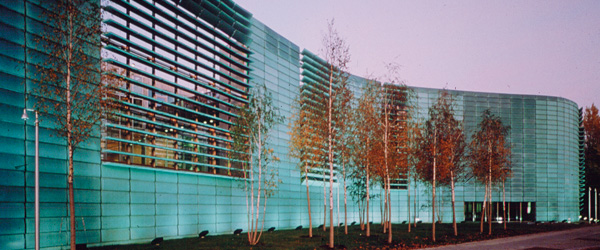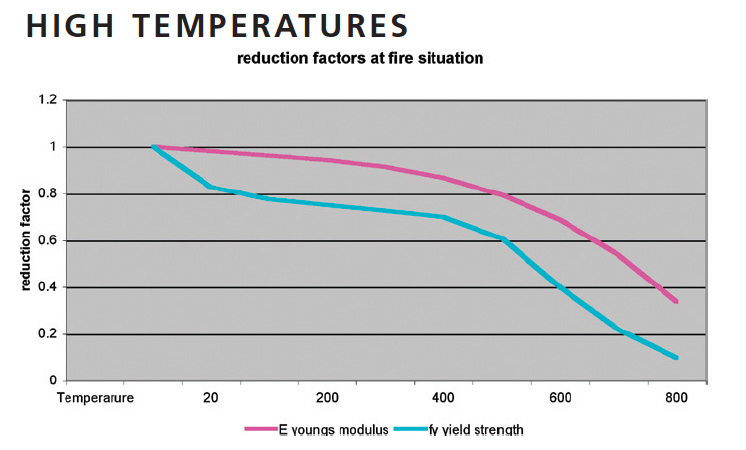Posted 1 July 2003

Stainless steel combines structural strength with corrosion resistance to form a superior construction material which additionally supports a range of aesthetically pleasing finishes.
The austenitic grades, typically 304 and 316, are most common and comprise 70% to 80% of all stainless steel used. Their popularity is due to their excellent corrosion resistance and mechanical properties combined with their relatively low cost. Nevertheless, the use of stainless steel hollow sections in construction has been restricted in the past by the unavailability of product larger than 150mm x 150mm x 6mm.
Today, however, the stainless steel industry internationally has the capacity to produce hollow sections up to 300mm x 300mm OD (outside dimensions) in thicknesses up to 12.5mm, matching the size range of carbon steel.
 Design Codes and Research
Design Codes and Research
The new AS/NZS 4673 gives minimum design requirements for static load bearing stainless members cold formed from annealed or temper rolled materials. Eurocode 3: Design of steel structures, Part 1-4: General rules - supplementary rules for stainless steel is the draft European standard for structural stainless steel design.
According to AS/NZS 4763, pending the release of Eurocode 3 as a European standard, the National Building Code of Finland used in conjunction with the draft Eurocode 3 part 1.2: General rules, structural fire design contains the most specific guidance on fire design for stainless steel members.
Finnish supplier Stalatube Oy has a research program which has concentrated on maximising stainless steel’s advantages as a construction material – corrosion and fire resistance, mechanical strength, easy maintenance and clean aesthetic looks. Good results have been found particularly in relation to work-hardening, which can more than double yield strength, and hold the increased values at temperatures up to 800°C.
Work Hardening
Normal austenitic stainless steel grades cannot be hardened by heat treatment. Hardening is achieved through cold-forming which increases mechanical properties such as the yield and tensile strength. This is particularly desirable in situations where weight is critical, for example in vehicles, or in construction where the design is enhanced by reducing bulk. Enhanced properties result in cost savings as well. The savings potential can be roughly calculated by comparing the enhanced yield strength to the base yield strength.
According to the European standard EC3 part 1.4 the design is based on the strength values shown in the table below.
| Grade | 0.2% proof stress, MPa min | Tensile strength MPa | Elongation A80, % min |
| EN 1.4301 (closest to grade 304) | 220 | 540-750 | 45 |
| EN 1.4404 (closest to grade 316L) | 230 | 530-680 |
40 |
Table 2 below compares the requirements of EC3 part 1.4 (the European standard for design) and ASTM A666 regarding proof stress (yield) and tensile strength values for austenitic stainless steel grades in cold worked state.
| Strength class | EN 0.2% proof stress, MPa min | Tensile strength, MPa min | ASTM A666 nearest temper |
| C700 | 350 | 700 | 1/8 Hard |
| C850 | 530 | 850 | 1/4 Hard |
he Australian Standard AS/NZS 4673:2001
permits the mechanical properties used for designing with austenitic grades to be established by testing of the finished product, ie, instead of testing a sample of the original plate or sheet, a section of the tube can be stretched to failure in a tensile testing machine to find the proof stress and ultimate tensile strengths. This allows the benefits of increased strength due to work hardening to be included when designing structures to the Australian Standard.

Over a short period, austenitic stainless steel sustains its mechanical values at higher temperatures than carbon steel. The figure above shows the reduction factors for elastic-modulus for stainless and 0.2% proof stress for an austenitic stainless steel. The sustainability of mechanical values makes it possible to obtain 30 minute fire resistance in stainless steel structures without any additional fire protection. These mechanical values are accepted in Finland as the basis for fire design in structures made of austenitic stainless steel hollow sections. In Australia it is possible to take advantage of the high temperature properties of stainless steels by carrying out fire tests, or by using the results of fire tests in conjunction with appropriate calculations.
The high temperature properties of stainless steel means that in suitable locations the intumescent coatings or other fire protection materials which would need to be applied to carbon steel are not required, allowing the stainless steel framing to be exposed. This is simpler and results in a much improved appearance and could be more economical and environmentally acceptable.
Designing with Stainless Hollow Sections
The qualities of stainless steel favour lightweight, slender structures, with a modern, classy feel and futuristic overtones. The combination of higher mechanical strength at room temperature and fire resistance makes stainless suitable for glass facades and glass roofs, accessways, stairways and balcony structures. A major application area in Australia is air distribution tube in sewage treatment plants.
For those projects where structural loads are being carried and design strength is critical, structural tube with guaranteed mechanical properties can be obtained; this generally implies a minimum 0.2% proof stress of 350MPa.
Designers opting for stainless steel are discovering that there is a wide range of products on the market. For example, Stalatube’s hollow sections begin with 25mm x 25mm tubes used for decorative purposes and go up to 300mm x 300mm (or 400mm x 200mm) for heavy structures with high load-bearing requirements. Profiles above 100mm x 100mm can be manufactured to customers’ own dimensions for maximum cost effectiveness. Australian stock is generally limited to 150mm in square sections although rectangular sections to 200mm x 100mm are available. Smaller sections down to about 12.7mm are also readily available. In addition to the “direct off mill” tube external finish, which is essentially that of the 2B of HRAP strip from which the tube was manufactured, grit polished product is routinely stocked in most common sizes. The polished finish presents an attractive and cost-effective product for visually exposed building components. Grit polished surfaces not only look more attractive in appropriate applications, the finish is also such that welded joints can be blended in, giving a more finished presentation.
Image 1 A 15m high, 230m long copper wall surrounds the Nordic Embassies in Berlin. A load-bearing stainless steel frame inside the enclosure supports the copper panels. The welded frame is made of polished (grit 320) 316 austenitic stainless steel hollow sections measuring 120mm x 120mm x 5mm. Stainless steel was chosen to satisfy low maintenance requirements and to provide a surface which doesn't react with the copper.
Image 2 Nokia House, Helsinki, has a double facade with single glazing 70cm from the front wall. The double facade has many advantages. The air gap between the wall and glazing cover acts as insulation, reducing the need for heating in winter and cooling in summer. It blocks traffic noise when the internal windows are opened and allows ventilation during rainy weather and below zero temperatures.
The load-bearing structures of the double facade are made from 90mm x 45mm x 3mm austenitic hollow sections with the glass fixed on the narrow side. The dimensions were calculated to satisfy the load bearing needs whilst maintaining the deflection needed to avoid the light atmosphere required. The building is located close to both the sea and the main western suburbs of Helsinki where traffic pollution occurs. Grade 316 tubes were chosen for this harsh environment.
Architect Helin & Co Structural Design Matti Ollila & Co
Words by Pekka Yrjola. Pekka Yrjola is a Research & Development Engineer at Stalatube Oy's head office in Lahti, Finland.
This article featured in Australian Stainless magazine - Issue 25, June 2003.